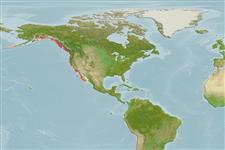>
Perciformes/Zoarcoidei (Eelpouts and pricklebacks) >
Opisthocentridae ("Rearspined fin pricklebacks")
Etymology: Lumpenopsis: Latin, lumpus, an uncouthlooking spiny-finned fish of a leaden-blue colour + Greek, opsis = appearance (Ref. 45335).
More on authors: Hubbs & Schultz.
Environment: milieu / climate zone / depth range / distribution range
นิเวศวิทยา
เกี่ยวกับทะเล,น้ำเค็ม กลุ่มสัตว์หน้าดิน,กลุ่มสัตว์พื้นท้องน้ำ; ระดับความลึก 30 - 100 m (Ref. 51666). Temperate
Eastern Pacific: southern British Columbia, Canada to California, USA.
ขนาด / น้ำหนัก / Age
Maturity: Lm ? range ? - ? cm
Max length : 7.6 cm TL เพศผู้/กระเทย; (Ref. 2850)
Short description
เครื่องมือที่ใช้ในการแยกชนิดสัตว์,สิ่งมีชีวิตออกจากกัน | สัณฐานวิทยา | ความยาวต่างๆ
เงี่ยงครีบหลัง (รวม) : 44; เงี่ยงครีบก้น: 1; ก้านครีบอ่อนที่ก้น: 31. Caudal oval; pectorals large, pointed (Ref. 6885).
Found in sandy to rocky bottoms (Ref. 51666).
Life cycle and mating behavior
วัยเจริญพันธุ์ | การสืบพันธุ์ | การวางไข่ | เซลสืบพันธ์ของเพศเมีย(ไข่) | ความดกของไข่ | ตัวอ่อน
Eschmeyer, W.N., E.S. Herald and H. Hammann, 1983. A field guide to Pacific coast fishes of North America. Boston (MA, USA): Houghton Mifflin Company. xii+336 p. (Ref. 2850)
IUCN Red List Status (Ref. 130435: Version 2024-2)
Threat to humans
Harmless
Human uses
เครื่องมือ
Special reports
Download XML
แหล่งที่มาจากอินเตอร์เน็ต
Estimates based on models
Preferred temperature (Ref.
123201): 8 - 11.8, mean 8.7 °C (based on 11 cells).
Phylogenetic diversity index (Ref.
82804): PD
50 = 0.5625 [Uniqueness, from 0.5 = low to 2.0 = high].
Bayesian length-weight: a=0.00102 (0.00046 - 0.00225), b=3.06 (2.88 - 3.24), in cm total length, based on all LWR estimates for this body shape (Ref.
93245).
ระดับชั้นอาหาร (Ref.
69278): 3.0 ±0.00 se; based on food items.
Fishing Vulnerability (Ref.
59153): Low vulnerability (10 of 100).
